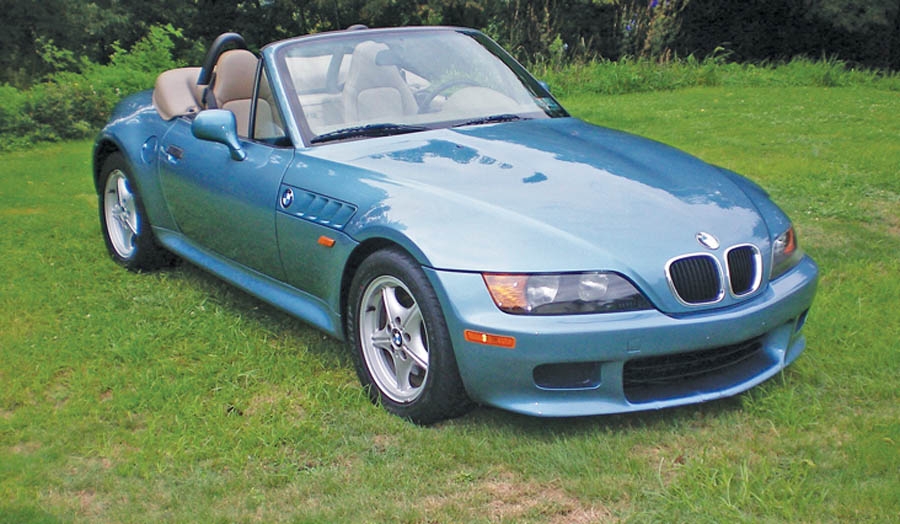
There’s nothing like a little wind in the old scalp, but if you were a BMW fan last century, there wasn’t much to choose from except a truly vintage two-seat roadster or the “rare-and-should-be” Z1 from 1989. That is, until the introduction of the Z3, way back in 1995.
The Z3 was a response to the wildly popular Mazda Miata — and recognition of the reappearing two-seater market niche. The successful introduction of the Miata in 1989 represented a sea change in the industry, proving — once again — that top-down motoring sells, and BMW wanted into the game.
The Z3 emerged from the design studio in a tidy package, based on the successful 3 Series E36 platform, with a 1.8-liter, 4-cylinder engine driving a 5-speed gearbox (or a problematic automatic). BMW tracked the early Miata customer feedback, and responded with a car that was slightly larger (seven inches longer), slightly heavier (400 pounds) and slightly more upscale. Motor Trend called it the equivalent of relaxed-fit jeans compared to the Miata.
Looks faster than it actually is
Based on lots of bits from the 3-Series parts bin, the Z3 was all about shape, and the early car was round and handsome, looking a lot faster parked than it was on the road, with 0–60 mph times around 10 seconds. The original body was restyled in 2000, getting a bit rounder, with a better soft top and much nicer interior touches, which was a corporate response to the early cars’ more utilitarian, not-quite-up-to-BMW-standard interiors.
The rather anemic early 1.8 4-cylinder engine was standard, but there was also an optional 2.8-liter, 6-cylinder producing 189 horsepower. Later models included a 3-liter engine producing 228 horses, with the boy-racer M version putting out 320 horsepower.
It wasn’t the look or the feel of the Z3 that launched it, though — it was brilliant marketing that established the success of the Z3. A product-placement deal made the Z3 the James Bond car in “GoldenEye,” the first Bond film to star Pierce Brosnan.
Bond, BMW and Neiman Marcus
Being the first non-British car for Bond to drive put plenty of Brit knickers in a twist in the run up to the film. The good news is the controversy generated millions of dollars of free advertising for the car. The original first-year production run of 15,000 cars (the Z3 was the first new model produced in BMW’s South Carolina plant) was sold out before the car was in showrooms.
There was also a special Neiman Marcus Christmas catalog Bond 007 Edition Z3, and all 100 examples sold. The Bond edition came only in Bond Blue Gray, and featured a few 007 touches, from dash plaque to leather interior, with a $35,000 sticker (not much of a premium over the base car price, which was slightly under $29,000). Sadly, they lacked the Stinger missiles behind the headlights that were found on the movie car.
More elegant, and heavier, vs. the Miata
The Z3 is undeniably handsome. Sitting next to a Miata of the same vintage, the Z3 just screams class and elegance in a way the Miata doesn’t. But sometimes the wrapping is better than the present. The interior space is tight, especially the footwells, despite the extra length. Should you have the top up, the view through the small plastic rear window is restricted, and that’s before it starts to fade and scratch (about two days after purchase).
But roadsters are all about driving — not looking good — and this is where the Z3 starts to fall down. First and foremost, they feel heavy with the 1.8, and they ARE heavy compared with the Miata.
The early Z3s are also noisy, and annoying rattles are often your traveling buddy on even the smoothest road. At least the six-speaker sound system is there to cover the rattles. The gearshift throws are nice and short — but notchy. Brakes are disc all around and work well, although the semi trailing-arm rear suspension (off the E30) can give you 911-like moments when you lift the throttle in a corner.
But none of that matters; you have to have one, don’t you? The good news is, they are out there and affordable.
Lots of inexpensive cars
There were more than 250,000 Z3s of various configurations produced over the six-year run. The rarest version is the Z3 M coupe, but that’s really a different discussion for us ragtop fans. Early 4-cylinder cars are plentiful at under $8,000, 6-cylinders for under $10,000, and a few Bond cars have achieved more than $20,000 sales at auction. Any Z3 M version is about a $4,000 premium.
The most recent sale was a pristine 1996 Z3 Bond Edition, with less than 6,000 miles on the odo, and it hammered for $24,200 (with commissions) at the Bonhams Greenwich Concours auction in May 2015.
For the collector, the Bond cars are auction outliers, with many more Z3s going for below $8,000 than $20,000 or more. So, at the end of the day, it’s an affordable little bucket of handsome fun, easy on the pocketbook and eyes. But unless you are looking at a Bond car, or an M version, you are buying a lovely driver, without expectation of appreciation any time soon. ♦
